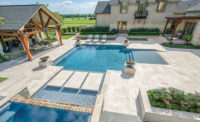

An abundance of Austin limestone, Texas flagstone and other materials such as round river rocks, were employed for some of the buildings to help create this "old-fashioned" look. A total of 85,000 tons of stone were used to complete the project. It was important that the project implement stone and all other resources, such as plant and wildlife, indigenous to the state of Texas. Austin limestone, quarried in large blocks, was used for the building facades of the Wells Fargo Bank and part of the General Store. The blocks had a nominal height of 8 to 10 inches and varied in length. The stones were irregularly laid in a brick pattern for one building, and were randomly laid in various size pieces for the other building's exterior.

The techniques involving the placement of the stone and the detailing and mortaring, depict an old-fashioned style of masonry. Struck joints, tool joints and slop joints were all used in various areas on the project.
The architects and installers researched the type of masonry prevalent in the nineteenth century to capture the same look for the Fort Worth Zoo Texas Wild! Hale explained that the architects took pictures of an old 1890s building, studying these less advanced methods of construction. The installers simulated these methods and used the same tools of that time to really capture the same antique look. This was a challenging task for the installer, explained Hale, as these older techniques greatly differ from today's more precise methods of construction. "The precision of construction in the 1890s is not what it is in this day in age," said Hale. The installer deliberately installed the stone pieces crooked and uneven to capture an old-time charm.

In addition to the limestone, Texas Flagstone was employed in random pieces for the porch of the bank building and was also used as paving for the sidewalk. According to Hale, the color of the stone and the technique in which it was laid greatly complemented the facade. Round river rocks were additionally used as a decorative touch for a fireplace within the caf?s well as for the outdoor tree planters.
The stone employed for the floors was laid in a bed of mortar with all the joints grouted. The random-sized pieces of Austin limestone, which were installed for the building facades, were laid as a veneer. Typical two-piece wall anchors were used to anchor the stone in place. The stonework for the project took four to five months to complete with a total of 15 masons. Products used for installing the stone included TXI Portland cement and Chemstar lime.
Work on the Fort Worth Zoo's "Texas Wild!" began in 1999. The project was fully completed by the summer of 2000.
Fort Worth Zoo - Texas Wild!
Fort Worth, TX
Project Manager: Linbeck Construction Corp., Fort Worth, TX
Stone Installer/Mason: C.B.C Masonry, Fort Worth, TX
Stone Supplier: Carroll Stone Supply, Weatherford, TX
